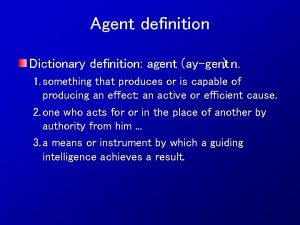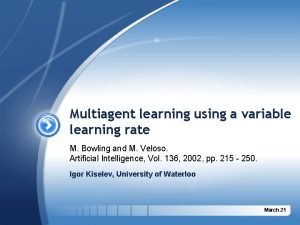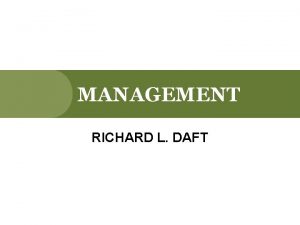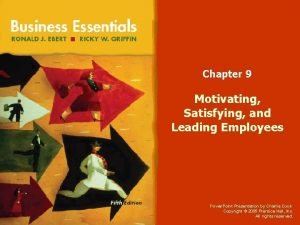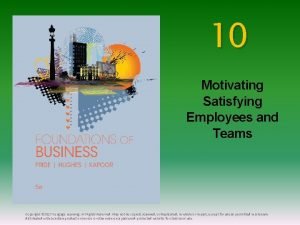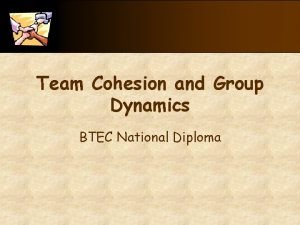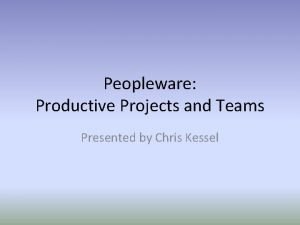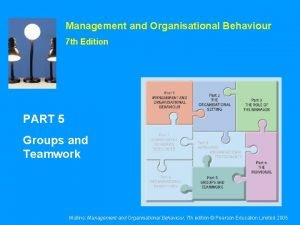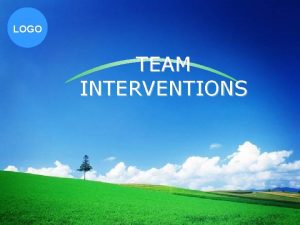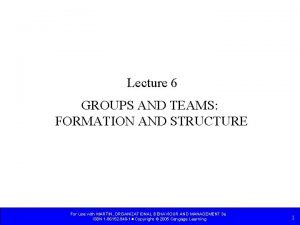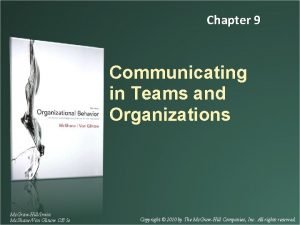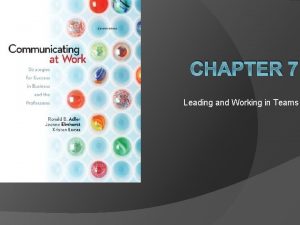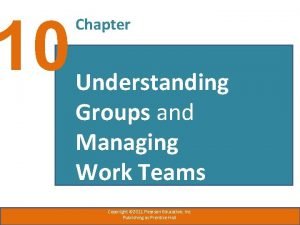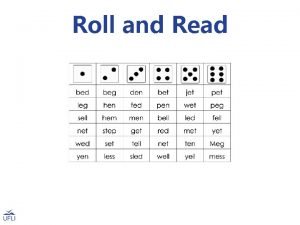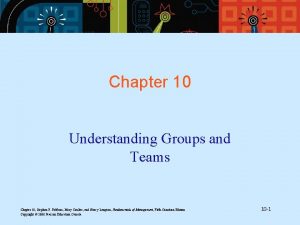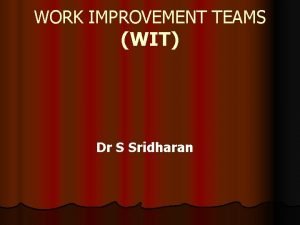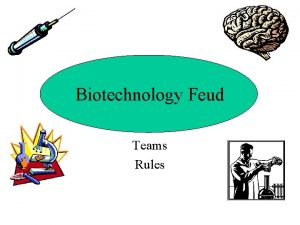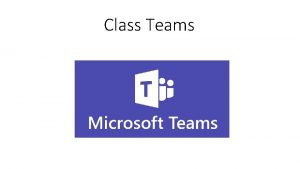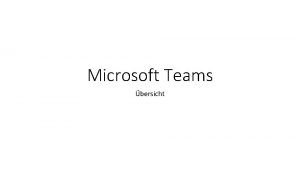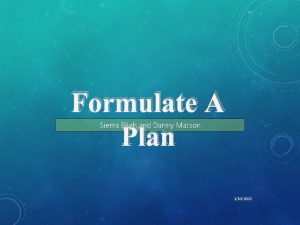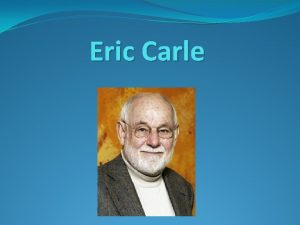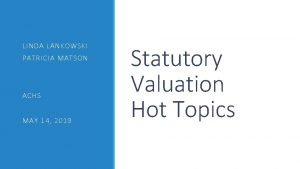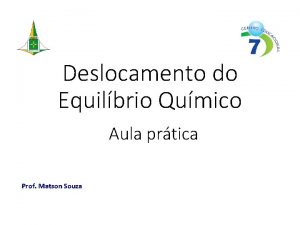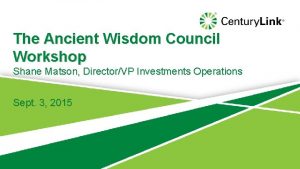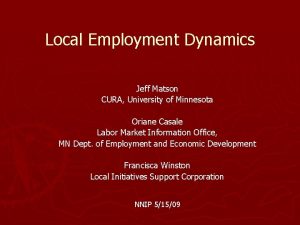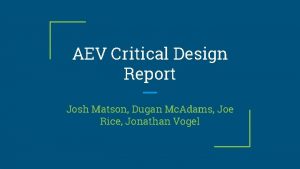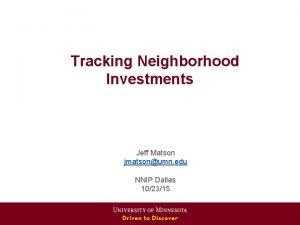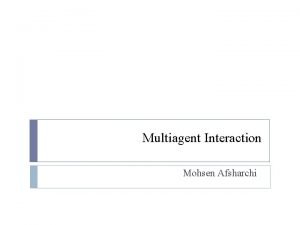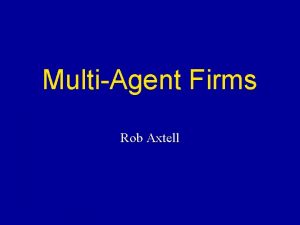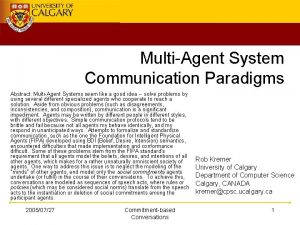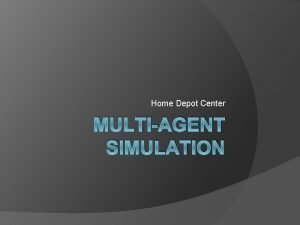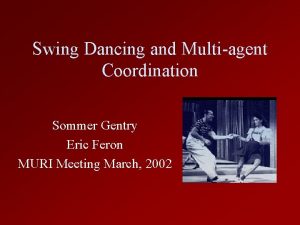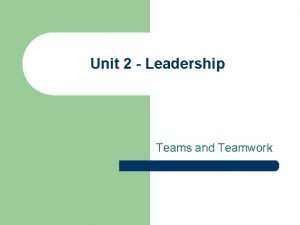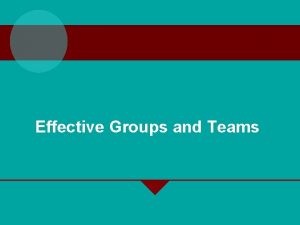Organization of MultiAgent Teams Eric Matson Multiagent and




















- Slides: 20

Organization of Multi-Agent Teams Eric Matson Multi-agent and Cooperative Robotics Lab Department of Computing and Information Sciences Kansas State University 234 Nichols Hall, Manhattan, KS 66506 matson@cis. ksu. edu 12/14/2021

Agenda l Introduction l Organization l Agent Organization Model l Domains and Implementation l Conclusions l Summary l Current and Future Research l Questions and Answers 12/14/2021

Introduction l What is organization? l defined: an organization as a task applied to the efforts of two or more people, a system of communication, a means of problem solving, and a means of facilitating decision making [Dale ’ 67]. Dale goes on to further describe organization: l l l (1) Determining what must be done if a given aim is to be achieved. (2) Dividing the necessary activities into segments small enough to be performed by one person. (3) Providing a means of coordination, so that there is no wasted effort and members of the organization do no get into each other's way. Why is organization important? l How can we use agent organizations? l 12/14/2021

Organization 1. 2. 3. 4. 5. 6. The mission goal must be defined from an intelligent agent or human source. The goal is used to generate plans to satisfy all goals. The plans are used to dynamically create decomposition structures to develop the definition of roles, rules, relationships and tasks. The available member’s skills and capabilities are inventoried and considered. The roles are matched to agents, based on capabilities, to roles to accomplish goals. The organization begins to work for accomplishment of goals 12/14/2021

Implementation Goal l Develop organizational model for implementing a sustainable cooperative agent team capable of long term execution l Self Organization and Reorganization l l l Self Reconfiguration Cooperative Sustainable l l 12/14/2021 Repair Adaptable

Agent Organization Model l Structure l Elements of an organization l Agents, Roles, Goals, Laws l State l Instance of an organization l Transition l State to State Initial Organization l Re-organization l 12/14/2021

Structure 12/14/2021

State Reorganization Instances Goals Roles Agents Capability Relationships Laws … State: 0 State: 1 State: 2 State: N Organization Duration: Initial State -> Goal Satisfaction 12/14/2021 Goal Satisfaction

Transition l Function of transition from one state to a new state l Examples Hiring a new person for a development team l Substituting a player during a basketball game l l Otransition = (O, Φ, δ, Sn, Soptimal, Spossible) l Transition function: δ(O, Φ, Sn) → S′ 12/14/2021

Goal: Search and Rescue Role: Rescuer Must move to where victim is located, pick up and return victim to base location YES Robot 1 Roll 12/14/2021 Active Grasp Roll Query: Who can play role? NO Sonar Role Capability Requirements Example Sonar Robot 2 Roll Sonar Active Grasp Agent Capability

Problem Domains Organizational Model Generic Human Current Projects Specific 12/14/2021 Future Projects EII Data Integration AIS Battle Intelligence Robotic Teams Cooperative Adaptive

AIS Overview l Tactical and Strategic Battlefield Intelligence l l l Sensor Networks to Provide Information l l Timely Continuous or Ad Hoc Sensor Loss Does Not Reduce the Information Requirements Adaptive Information System (AIS) must: l l 12/14/2021 Overcome the Loss of Sensor Instances Provide Continuous Information Flow

AIS Implementation l Battlefield Contains Many Sensor Types l l Human Mechanical Organize, Synthesize and Merge Streams l Structure l l Agent Types l l l Data Sensor Synthesis Query Self Organization 12/14/2021

AIS Conclusions l Combination Models can: of AIS and Organization Provide a Flexible System l Overcome Sensor Loss l Compensate Through Self-Organization l l Simulation l Worked to reorganize when possible l Actual l 12/14/2021 (100 K Scenarios) Battlefield Less success due to Physical

Robotic Teams In Progress Complex Capabilities And Teamwork Higher Level Function Environmental Learning Behaviors agent. Tool agent. Mom Existing Organization Computation Capability Abstraction Layer Integration Connectors Generic Integration Layer Aria C++ C Mini Java ? ? Java Java Activ. Media Amigo. Bot Activ. Media Pioneer Nomadic Parallax Javelin 12/14/2021

Robot Team Conclusions l Agent Organization can be applied to robotics Self-reconfiguration l Adaptability l Sustainable l l Architecture supports many robotic instances, regardless of implementation 12/14/2021

Current Research l l l Capability classification of robotic agents l Computational l Physical Integrate: l Concepts of computational organization theory into teamwork theories l Methods for developing teams of cooperative robots. Organizational rules to define proper organizational function. Extend general-purpose reorganization algorithms Incorporate organizational design and knowledge into agentoriented software methods l Multi-agent systems design l Application to Cooperative Robotics. 12/14/2021

Future l Effects of. Research attrition/recovery on sustainable teams (current model) l Decision points for organizations l l l Goal satisfaction Goal relaxation Effective reorganization function l l Structural composition of capabilities Capability synthesis algorithms Developing capabilities for one (or more) robotic team member to: l Repair l Restore l Mixed-initiative programs l Employment of human agents, as part of the cooperative organization l Human capability to elevate cooperative goal satisfaction strategies l 12/14/2021

Summary l Goal is to implement agent teams using organizational model with the following characteristics: l l Flexibility with broad domain application l l l Adaptive Information Systems (AIS) Robotic teams Current working architecture to support the model l Recoverable Adaptable Sustainable Developing higher level organizational function Environmental learning Reasoning about effective organization function 12/14/2021

Questions ? 12/14/2021
 Gent urban dictionary
Gent urban dictionary Multiagent learning using a variable learning rate
Multiagent learning using a variable learning rate Block arrangement compare and contrast
Block arrangement compare and contrast Process organization in computer organization
Process organization in computer organization Chapter 10 motivating and satisfying employees and teams
Chapter 10 motivating and satisfying employees and teams Motivating and satisfying employees and teams
Motivating and satisfying employees and teams Chapter 10 motivating and satisfying employees and teams
Chapter 10 motivating and satisfying employees and teams Motivating and satisfying employees and teams
Motivating and satisfying employees and teams Copyright
Copyright Examples of social loafing in sport
Examples of social loafing in sport Peopleware definition
Peopleware definition What's the difference between group and team
What's the difference between group and team Groups and teams difference
Groups and teams difference Groups and teams difference
Groups and teams difference Communicating in teams and organizations
Communicating in teams and organizations Leading and working in teams
Leading and working in teams Understanding groups and teams
Understanding groups and teams Read roll
Read roll Understanding groups and teams
Understanding groups and teams Understanding groups and teams
Understanding groups and teams Work improvement teams singapore
Work improvement teams singapore
